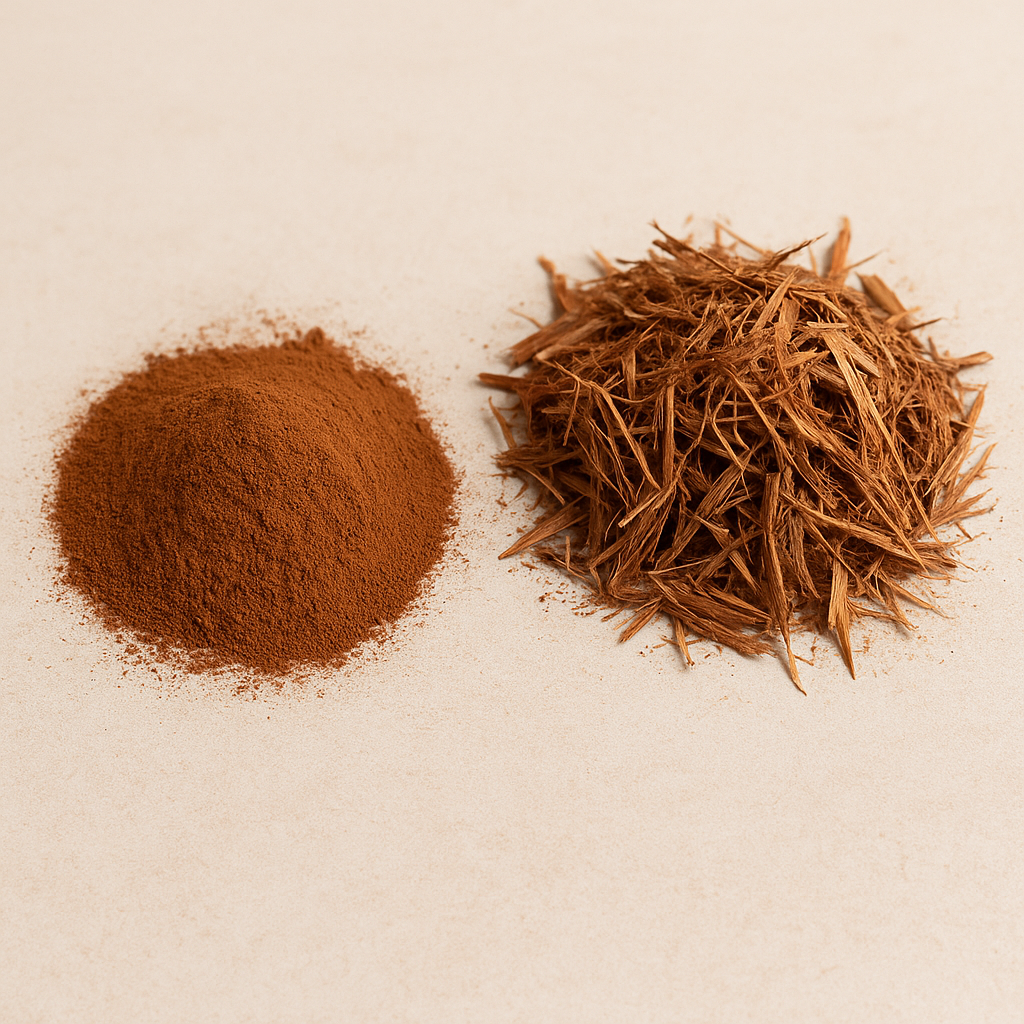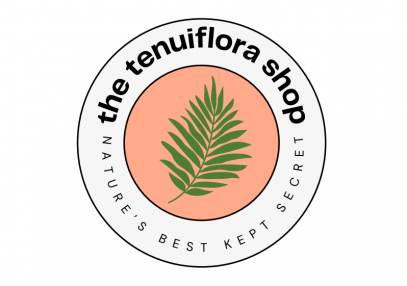Mimosa Hostilis Root Bark (MHRB) is one of the most widely used natural botanical ingredients in artisan dyeing, soapmaking, tincture preparation, and various traditional craft practices. While it’s always the same plant, the two most common forms available to creators — powder and shredded bark — behave very differently in extraction, color development, workflow, and final results.
Because of those differences, people often search for clarity on mhrb powder vs shredded bark, and it can be hard to find a complete, well-structured explanation. This guide breaks down how each form performs, what makes them distinct, and how to choose the right one for your project. The goal is not to promote one form over the other, but to offer an unbiased, educational resource for anyone working with natural materials.

Understanding What MHRB Powder Actually Is
MHRB powder is the root bark ground into a fine, flour-like consistency. Grinding the bark increases its surface area dramatically, which allows pigments and botanical compounds to release faster during extraction.
Characteristics of the Powder Form
- Fine, lightweight texture
- Rapid extraction
- Even pigment distribution
- Faster color development
- Works well for small-batch experiments
- Ideal for liquid-based formulations
Because of its small particle size, powder is used frequently in tincture bases, masks, test batches, and any application where speed and precision matter. When comparing mhrb powder vs shredded bark, powder is typically the faster and more predictable form in terms of extraction behavior.
Understanding What Shredded Bark Is
Shredded MHRB consists of thin fibrous strips of the root bark. These maintain much of the plant’s original structure, including oils, tannins, and natural fibers, making extraction slower but deeper.
Characteristics of the Shredded Form
- Slow, steady extraction
- Retains structural integrity
- Produces complex, earthy tones
- Easier to strain and filter
- Best for large dye baths
- Ideal for traditional simmering
Shredded bark is often preferred for multi-yard fabric dyeing or large-volume simmering because it behaves consistently over a long period. When comparing mhrb powder vs shredded bark, shredded bark is favored for longer, traditional processes that require depth and clarity.
How Particle Size Changes Extraction Results
The most significant difference in mhrb powder vs shredded bark comes from particle size. Smaller particles release pigment quickly, while larger pieces allow pigment to emerge gradually. This shapes everything from color saturation to temperature control.
Powder Extraction Behavior
- Immediate pigment release
- Requires shorter simmer times
- Excellent for concentrated extractions
- Can become muddy if overheated
- Harder to filter due to fine particles
Shredded Bark Extraction Behavior
- Gradual pigment release
- Ideal for extended simmering
- Produces layered, consistent color
- Easy to strain and clarify
- Less risk of over-extraction
Because natural materials behave differently from batch to batch, understanding these differences gives creators more control and predictability in their work.
Color Development: Fast vs Slow
When discussing mhrb powder vs shredded bark, color development is one of the most noticeable differences.
Color Results With Powder
Powder tends to produce fast, bright tones quickly. It is often used when creators want:
- Quick color tests
- Strong early pigmentation
- Smooth, uniform color in liquids
However, the rapid pigment release can make the dye more reactive to temperature, sometimes resulting in a darker or browner color if overheated.
Color Results With Shredded Bark
Shredded bark develops:
- Darker tones
- More balanced undertones
- More “traditional” natural dye hues
- Better stability over time
Because pigments release slowly, shredded bark offers more nuance and fewer abrupt shifts.
For readers who want to understand MHRB color behavior in dyeing more deeply, explore this educational guide.
How Each Form Performs in Natural Dyeing
Natural dyeing is the most common reason people compare mhrb powder vs shredded bark, because the form you choose directly affects the workflow and the final color.
Powder in Dyeing
Powder disperses quickly into water, sometimes requiring only minutes to release color. It is excellent for:
- Swatches
- Small garments
- One-off color tests
- Soap colorants
- Liquid dyes requiring speed
The trade-off is that it produces fine sediment, which must be strained carefully.
Shredded Bark in Dyeing
Shredded bark is the traditional choice for:
- Multi-yard fabric dyeing
- Large simmer pots
- Repeated dips
- Long extraction techniques
Because the pieces are larger, shredded bark creates a clearer dye bath and is easier to filter.
How Each Form Performs in Soapmaking
Soapmakers often debate mhrb powder vs shredded bark because each form affects the soap differently.
Using Powder in Soap
Powder blends smoothly into lye water or oils. It produces:
- Even distribution
- Predictable color
- No infusion required
- Stronger early color intensity
Using Shredded Bark in Soap
Shredded bark requires infusing into water or oil before adding to soap. It produces:
- Earthier tones
- A more rustic look
- Slight variation from batch to batch
- Gradual buildup of color
Shredded bark results in soap bars that feel closer to traditional botanical crafts.
Filtration, Cleanup, and Workflow Considerations
When examining mhrb powder vs shredded bark, workflow is an overlooked but important factor.
Powder Workflow
- Faster overall
- Requires finer filtration
- Can leave subtle sediment
- More precise for formulation work
Shredded Workflow
- Slower, more hands-on
- Easy straining
- Cleaner liquid extracts
- Ideal for volume-based projects
Creators who prefer efficiency may choose powder. Those who enjoy slower, traditional processes may choose shredded bark.
Storage and Shelf Life
Both forms store well when kept properly, but there are subtle differences.
Powder Storage
- Most sensitive to humidity
- Should be in airtight jars or mylar bags
- Should be kept away from light
- More prone to clumping
Shredded Storage
- Slightly more forgiving
- Retains aroma and pigment longer
- Better for long-term bulk storage
- Easier to scoop and measure
When discussing mhrb powder vs shredded bark, shredded bark typically wins for long-term storage stability.
Combining Both Forms for Advanced Techniques
Experienced creators sometimes combine both forms in a single extraction or dye bath. This allows them to balance:
- Fast early pigmentation (from powder)
- Deep, layered color (from shredded)
A common method is:
- Start with shredded bark to build depth
- Add a small amount of powder to intensify color
- Simmer gently to blend both extraction patterns
This technique creates richer and more nuanced tones than using either form alone.
Choosing the Right Form for Your Project
The question of mhrb powder vs shredded bark only matters if you know what you’re trying to accomplish. Natural materials do not behave identically from batch to batch, so understanding what you need helps you choose wisely.
Choose Powder If You Want:
- Fast results
- Clear, concentrated color
- Small project control
- Smooth blending
- Efficient extraction
Choose Shredded If You Want:
- Gradual, traditional extraction
- Depth and stability
- Large dye batch consistency
- Easy filtration
- Classic botanical techniques
There is no right or wrong choice — only what fits your creative process.
Scientific Context: Why Tannins Extract Differently
For readers who want a deeper understanding of MHRB extraction, see this authoritative research on tannin-rich botanicals:
This study explains how tannins behave differently depending on particle size, oxidation, heat, and surface area — all factors that influence mhrb powder vs shredded bark extraction.
Final Thoughts: Understanding Natural Variation
Understanding mhrb powder vs shredded bark is about more than choosing between fast or slow extraction. It’s about knowing how the form you choose influences:
- Color development
- Workflow
- Filtration
- Stability
- Consistency
- Final feel of the project
Natural materials are dynamic. No two batches of bark will behave exactly the same, even within the same form. Learning how each version behaves gives you more control and allows you to work more intuitively with the plant.
Whether you use powder, shredded, or a combination of both, knowing the differences ensures that your dyeing, crafting, soapmaking, or botanical extraction work is as consistent and rewarding as possible.
